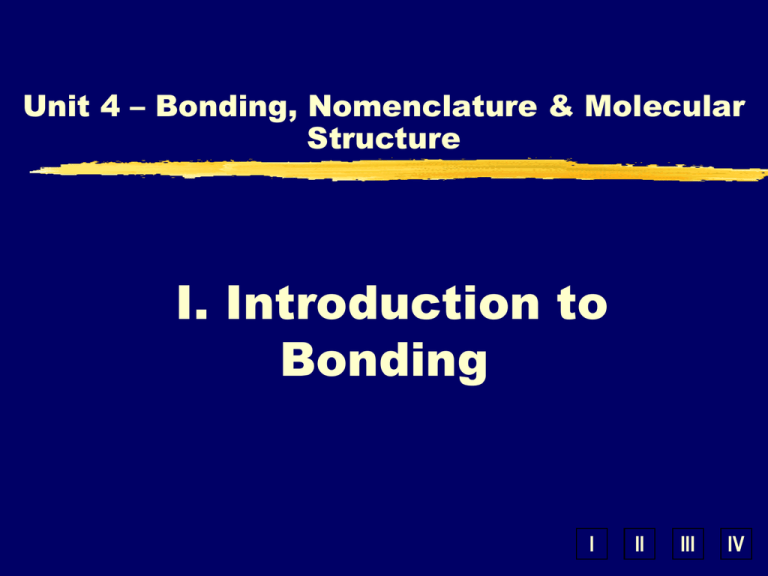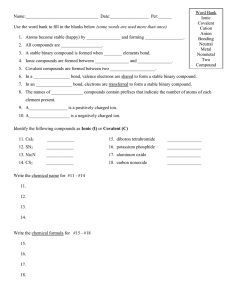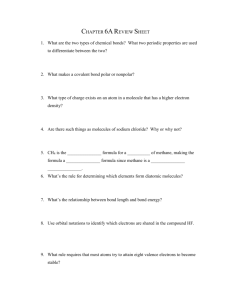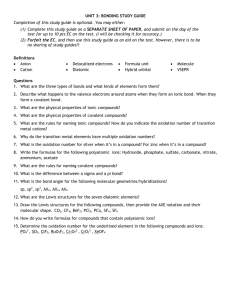II. Molecular Compounds - Phillips Scientific Methods
advertisement

Unit 4 – Bonding, Nomenclature & Molecular Structure I. Introduction to Bonding I II III IV Vocabulary Chemical Bond attractive force between atoms or ions that binds them together as a unit bonds form in order to… decrease potential energy (PE) increase stability Vocabulary Molecule Smallest electrically neutral unit of a substance that still has the properties of the substance Made up of 2 or more atoms Ion Atom or group of atoms that have a positive or negative charge Vocabulary ION 1 atom 2 or more atoms Monatomic Ion Polyatomic Ion + Na NO3 - Vocabulary COMPOUND 2 elements Binary Compound NaCl more than 2 elements Ternary Compound NaNO3 Vocabulary CHEMICAL FORMULA IONIC COVALENT Formula Unit Molecular Formula NaCl CO2 Types of Bonds IONIC COVALENT Bond Formation e- are transferred from metal to nonmetal e- are shared between two nonmetals Type of Structure crystal lattice true molecules Physical State solid liquid or gas Melting Point high low Solubility in Water yes usually not Electrical Conductivity yes (solution or liquid) no Other Properties odorous Types of Bonds/Compounds Ionic Bonding - Crystal Lattice Types of Bonds/Compounds Ionic Bonding Types of Bonds/Compounds Covalent Bonding - True Molecules Diatomic Molecule Types of Bonds/Compounds Covalent Bonding Types of Bonds/Compounds METALLIC Bond Formation e- are delocalized among metal atoms Type of Structure “electron sea” Physical State solid Melting Point very high Solubility in Water no Electrical Conductivity yes (any form) Other Properties malleable, ductile, lustrous Types of Bonds/Compounds Metallic Bonding - “Electron Sea” Determining Bond Type Most bonds are a blend of ionic and covalent characteristics. Difference in electronegativity determines bond type. Determining Bond Type Electronegativity Attraction an atom has for a shared pair of electrons. higher e-neg atom lower e-neg atom + Determining Bond Type Electronegativity Trend Increases up and to the right. Determining Bond Type Nonpolar Covalent Bond e- are shared equally symmetrical e- density usually identical atoms Determining Bond Type Polar Covalent Bond e- are shared unequally asymmetrical e- density results in partial charges (dipole) + Determining Bond Type Nonpolar Polar Ionic How To Determine the Bond Type Using Electronegativity Differences nonpolar 0 to 0.4 = ______________ covalent bond polar 0.5 to 2.0 = _____________ covalent bond ionic Above 2.0 = _______________ bond Practice Problems: Determine the type of bond that forms between the atoms in the following compounds. 2.5 3.5 0.9 3.0 a) CO2 b) NaCl 1.0 = polar covalent 2.1 = ionic 2.5 2.1 c) CH4 0.4 = nonpolar covalent Unit 4 – Bonding & Molecular Structure II. Ionic Compounds I II III IV Octet Rule Octet Rule Most atoms form bonds in order to obtain 8 valence eFull energy level stability ~ Noble Gases Ne Lewis Structures Electron Dot Diagrams used to show bonding Ionic Compounds – show transfer of e- Lewis Structures cation + anion = ionic compound Cation or Anion? How do you determine whether an atom loses or gains electrons? Look at the group # What does that tell you? Ask yourself, “is it easier to LOSE ______ electrons or GAIN ____ electrons to achieve the octet?” Practice Problem Aluminum and nitrogen Al has __ valence electrons - will it lose __ or gain __? - Al becomes… N has __ valence electrons - will it lose ___ or gain __? - N becomes… Barium and Sulfur Ba [Xe] ____ 6s Which noble gases will they look like after they react? S [Ne] ___ 3s ___ ___ ___ 3p After reacting… Ba2+ [Xe] ____ 6s S2[Ne] ___ 3s ___ ___ ___ 3p Looks like Argon REVIEW - Common Ion Charges 1+ 0 2+ 3+ NA 3- 2- 1- Naming Type I Binary Compounds (single-charge cations) Write the names of both ions, cation first. Change ending of monatomic ions to -ide. Examples: SrS AlBr3 Formulas for Type I Binary Compounds (single-charge cations) Write each ion, cation first. Don’t show charges in the final formula. Overall charge must equal zero. If charges cancel, just write symbols. If not, use subscripts to balance charges. Some transition metals have only 1 charge: Ag+ Zn2+ Cd2+ Criss-Cross Rule Example: Aluminum Chloride Step 1: Al3+ Cl1- Al 1 Cl 3 write symbols & charge of elements Step 2: criss-cross charges as subscripts Step 3: combine as formula unit (“1” is never shown) AlCl 3 Criss-Cross Rule Example: Aluminum Oxide Step 1: Al3+ O2- Step 2: Al 2 O3 Step 3: Al2O3 PRACTICE Type I Binary Compounds WS (SingleCharge Cations) Naming Type II Binary Compounds (multiple-charge cations) Since the metal ion can have more than one charge, a Roman numeral is used to specify the charge. Determine the charge on the cation using the charge on the anion Example: NiBr2 NiBr2 = nickel (II) bromide Common Cations and Anions Naming Type II Binary Compounds (multiple-charge cations) PRACTICE PROBLEMS 1. 2. 3. 4. 5. CuCl HgO Fe2O3 MnO2 PbCl2 copper (I) chloride _________________ mercury (II) oxide _________________ iron (III) oxide _________________ manganese (IV) oxide _________________ lead (II) chloride _________________ Formulas for Type II Binary Compounds (multiple-charge cations) Roman numerals indicate the ion’s charge. Examples: 1. Iron (III) chloride 2. Tin (IV) oxide 3. Lead (II) sulfide FeCl3 ________ SnO2 ________ PbS ________ PRACTICE Multiple-Charge Cations WS Formulas for Ternary Compounds (polyatomic ions) Use parentheses to show more than one polyatomic ion. Example: Ca3(PO4)2 Naming Ternary Compounds PRACTICE PROBLEMS NaNO2 sodium nitrite KClO2 potassium chlorite Ba3(PO4)2 barium phosphate Fe(OH)3 iron (III) hydroxide NaHCO3 sodium bicarbonate ‘sodium hydrogen carbonate’ Criss Cross Rule – Ternary Compounds Example: Magnesium Phosphate Step 1: Mg2+ PO43- Step 2: Mg3 (PO4) 2 Step 3: Mg3(PO4)2 More Ternary Compound Examples 1. Zn3(PO4)2 ________________ 2. (NH4)2CO3 ________________ 3. Al2(SO4)3 ________________ aluminum sulfate 4. Na2SO4 sodium sulfate ____________________ 5. LiCN lithium cyanide ____________________ 6. Ba(ClO3)2 7. Cu(OH)2 ________________ zinc phosphate ammonium carbonate barium chlorate ____________________ copper (II) hydroxide PRACTICE Ternary Compounds WS Go Fish For An Ion Acceptable Matches Na+ Na+ SO4 2Al3+ Cl- Cl- Cl Unacceptable Matches Li+ Na+ SO4 2Al3+ O2- Go Fish Scoring Cation # Cations Anion # Anions Chemical Formula Cu2+ 1 OH- 2 Cu(OH)2 Points Unit 4 – Bonding, Nomenclature & Molecular Structure III. Molecular / Covalent Compounds (Type III Binary Compounds) I II III IV Energy of Bond Formation Potential Energy based on position of an object low PE = high stability Energy of Bond Formation Potential Energy Diagram attraction vs. repulsion no interaction increased attraction Energy of Bond Formation Potential Energy Diagram attraction vs. repulsion increased repulsion balanced attraction & repulsion Energy of Bond Formation Bond Energy Energy required to break a bond Bond Energy Bond Length Energy of Bond Formation Bond Energy Short bond = high bond energy Naming Type III Binary Compounds Prefix System 1. Less e-neg atom comes first. 2. Add prefixes to indicate # of atoms. Omit mono- prefix on first element. 3. Change the ending of the second element to -ide. Naming Type III Binary Compounds PREFIX monoditritetrapentahexaheptaoctanonadeca- NUMBER 1 2 3 4 5 6 7 8 9 10 Naming Type III Binary Compounds PRACTICE PROBLEMS CCl4 carbon tetrachloride N2O dinitrogen monoxide SF6 sulfur hexafluoride Formulas for Type III Binary Compounds PRACTICE PROBLEMS arsenic trichloride AsCl3 dinitrogen pentoxide N2O5 tetraphosphorus decoxide P4O10 The 7 Diatomic Elements Br2 I2 N2 Cl2 H2 O2 F2 H N O F Cl Br I Naming Binary Compounds - REVIEW Unit 4 – Bonding, Nomenclature & Molecular Structure IV. Acids I II III IV Definition Acids Compounds that form H+ in water. Formulas usually begin with ‘H’. Examples: HCl – hydrochloric acid HNO3 – nitric acid H2SO4 – sulfuric acid Acid Nomenclature Anion Ending Acid Name -ide hydro-(stem)-ic acid -ate (stem)-ic acid -ite (stem)-ous acid Acid Nomenclature ACIDS start with 'H' 2 elements 3 elements hydro- prefix -ic ending no hydro- prefix -ate ending becomes -ic ending -ite ending becomes -ous ending Acid Nomenclature HBr (aq) 2 elements, -ide hydrobromic acid carbonic acid sulfurous acid H2CO3 (aq) 3 elements, -ate H2SO3 (aq) 3 elements, -ite Acid Nomenclature hydrofluoric acid 2 elements H + F- HF (aq) sulfuric acid 3 elements, -ic H+ SO42- H2SO4(aq) nitrous acid 3 elements, -ous H+ NO2- HNO2 (aq) PRACTICE Acids WS Nomenclature Review Flow Chart Formula Name? Metal + Nonmetal? (Except: NH4+) Two Nonmetals? Ionic d,f-block Pb,Sn Multiple Groups 1A, 2A, 3A Ag+, Zn2+, Cd2+ Single Covalent Steps 1 & 4 ONLY 1. Write name of cation (metal) 2. Determine the charge on the metal by balancing the (-) charge from the anion 3. Write the charge of the metal in Roman Numerals and put in parentheses 4. Write name of anion (Monatomic anions need –ide ending!) Use Prefixes!!! *Mono* Hexa Di Hepta Tri Octa Tetra Nona Penta Deca Name Formula? No Prefixes? Ionic Prefixes? Covalent 1. Determine the ions present and the charge on each (Roman Numeral = cation charge, otherwise use PT) 1. FORGET CHARGES!!! 2. Balance formula (criss-cross) 3. Do NOT reduce subscripts! 3. Reduce subscripts (if needed) 2. Use prefixes to determine subscripts




